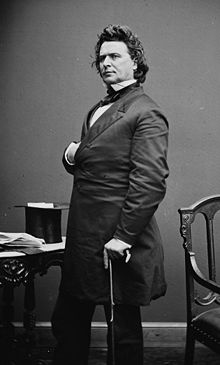James Mitchell Ashley
| James Mitchell Ashley | |
|---|---|
 |
|
| Member of the U.S. House of Representatives from Ohio's 5th district |
|
|
In office March 4, 1859 – March 3, 1863 |
|
| Preceded by | Richard Mott |
| Succeeded by | Francis Celeste Le Blond |
| Member of the U.S. House of Representatives from Ohio's 10th district |
|
|
In office March 4, 1863 – March 3, 1869 |
|
| Preceded by | Carey A. Trimble |
| Succeeded by | Truman H. Hoag |
| Montana Territory Governor | |
|
In office April 9, 1869 – July 12, 1870 |
|
| Preceded by | Green Clay Smith |
| Succeeded by | Benjamin Franklin Potts |
| Personal details | |
| Born |
November 14, 1824 Allegheny County, Pennsylvania |
| Died | September 16, 1896 (aged 71) Ann Arbor, Michigan |
| Resting place | Woodlawn Cemetery (Toledo, Ohio) |
| Political party | Republican |
| Spouse(s) | Emma Smith |
| Children | four |
James Mitchell Ashley (November 14, 1824 – September 16, 1896) was an American politician and abolitionist. A member of the Republican Party, Ashley served as a member of the United States House of Representatives from Ohio during the American Civil War, where he became a leader of the Radical Republicans and pushed for passage of the Thirteenth Amendment, ending slavery in the United States. After the war, he served as Governor of Montana Territory and president of the Ann Arbor Railroad.
Ashley was born in Allegheny County, Pennsylvania, to John Ashley, a bookbinder and Campbellite preacher who evangelized in Kentucky and West Virginia, and his wife Mary A. (Kilpatrick) Ashley of Kentucky. As a boy in the Ohio River valley, Ashley saw coffles of chained slaves being walked to the Deep South, boys his own age being sold, and even white men who refused to let their cattle drink from a stream in which his father had baptized slaves. He grew to hate the "peculiar institution" (which he considered a violation of Christian principles) and the oligarchy that supported it.
Ashley was mostly self-taught in elementary subjects, although his father wanted him to follow family tradition and become a Baptist minister. Rather than attend a seminary, the 14 year old youth ran away to become a cabin boy on Ohio and Mississippi River boats, and later worked as a clerk on those boats. He had begun helping slaves to escape as early as 1839, and late in his life Ashley relished telling stories of the families he had saved as a 17 year old.
...
Wikipedia
